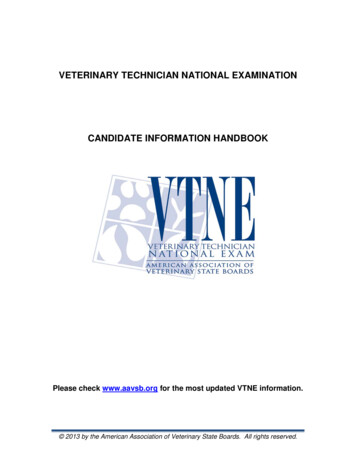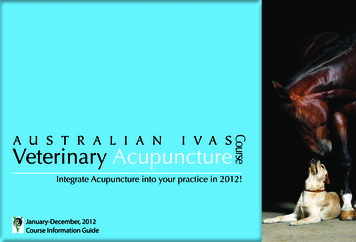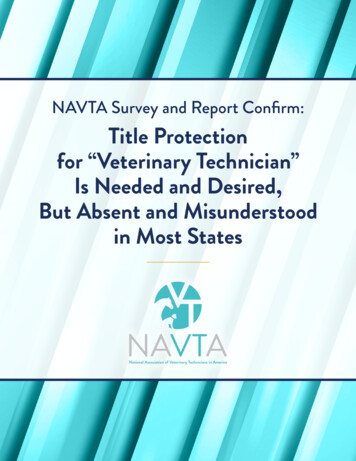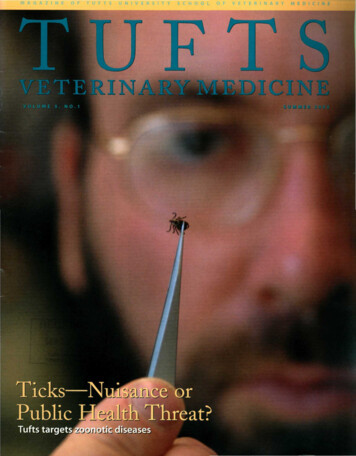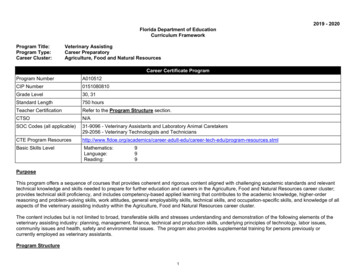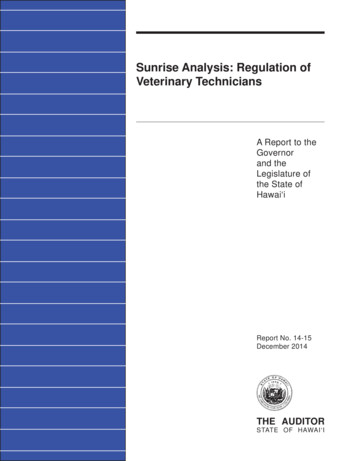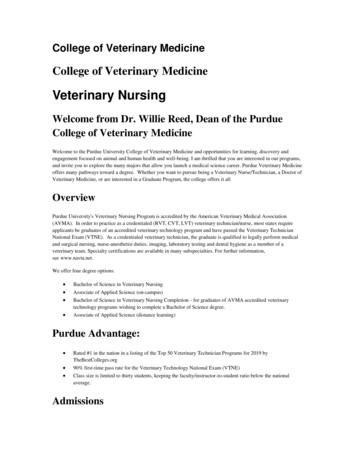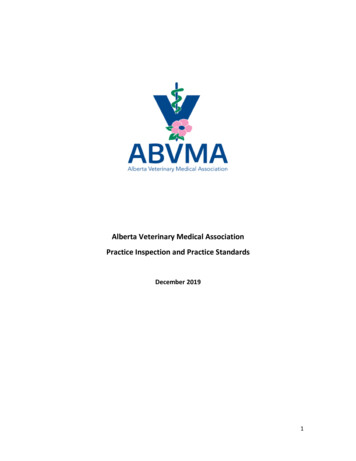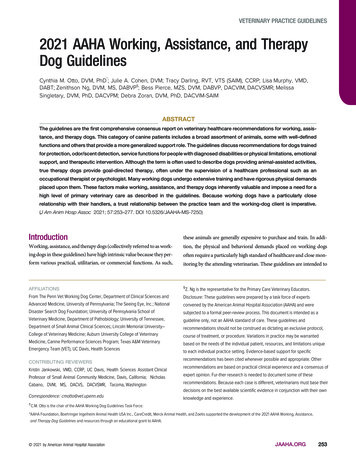
Transcription
VETERINARY PRACTICE GUIDELINES2021 AAHA Working, Assistance, and TherapyDog GuidelinesCynthia M. Otto, DVM, PhD†; Julie A. Cohen, DVM; Tracy Darling, RVT, VTS (SAIM), CCRP; Lisa Murphy, VMD,DABT; Zenithson Ng, DVM, MS, DABVP§; Bess Pierce, MZS, DVM, DABVP, DACVIM, DACVSMR; MelissaSingletary, DVM, PhD, DACVPM; Debra Zoran, DVM, PhD, DACVIM-SAIMABSTRACTThe guidelines are the first comprehensive consensus report on veterinary healthcare recommendations for working, assistance, and therapy dogs. This category of canine patients includes a broad assortment of animals, some with well-definedfunctions and others that provide a more generalized support role. The guidelines discuss recommendations for dogs trainedfor protection, odor/scent detection, service functions for people with diagnosed disabilities or physical limitations, emotionalsupport, and therapeutic intervention. Although the term is often used to describe dogs providing animal-assisted activities,true therapy dogs provide goal-directed therapy, often under the supervision of a healthcare professional such as anoccupational therapist or psychologist. Many working dogs undergo extensive training and have rigorous physical demandsplaced upon them. These factors make working, assistance, and therapy dogs inherently valuable and impose a need for ahigh level of primary veterinary care as described in the guidelines. Because working dogs have a particularly closerelationship with their handlers, a trust relationship between the practice team and the working-dog client is imperative.(J Am Anim Hosp Assoc 2021; 57:253–277. DOI 10.5326/JAAHA-MS-7250)Introductionthese animals are generally expensive to purchase and train. In addi-Working, assistance, and therapy dogs (collectively referred to as work-tion, the physical and behavioral demands placed on working dogsing dogs in these guidelines) have high intrinsic value because they per-often require a particularly high standard of healthcare and close mon-form various practical, utilitarian, or commercial functions. As such,itoring by the attending veterinarian. These guidelines are intended toAFFILIATIONS§From The Penn Vet Working Dog Center, Department of Clinical Sciences andDisclosure: These guidelines were prepared by a task force of expertsAdvanced Medicine, University of Pennsylvania; The Seeing Eye, Inc.; Nationalconvened by the American Animal Hospital Association (AAHA) and wereDisaster Search Dog Foundation; University of Pennsylvania School ofVeterinary Medicine, Department of Pathobiology; University of Tennessee,Department of Small Animal Clinical Sciences; Lincoln Memorial University–College of Veterinary Medicine; Auburn University College of VeterinaryMedicine, Canine Performance Sciences Program; Texas A&M VeterinaryEmergency Team (VET), UC Davis, Health SciencesCONTRIBUTING REVIEWERSKristin Jankowski, VMD, CCRP, UC Davis, Health Sciences Assistant ClinicalProfessor of Small Animal Community Medicine, Davis, California; NicholasZ. Ng is the representative for the Primary Care Veterinary Educators.subjected to a formal peer-review process. This document is intended as aguideline only, not an AAHA standard of care. These guidelines andrecommendations should not be construed as dictating an exclusive protocol,course of treatment, or procedure. Variations in practice may be warrantedbased on the needs of the individual patient, resources, and limitations uniqueto each individual practice setting. Evidence-based support for specificrecommendations has been cited whenever possible and appropriate. Otherrecommendations are based on practical clinical experience and a consensus ofexpert opinion. Fur-ther research is needed to document some of theseCabano, DVM, MS, DACVS, DACVSMR, Tacoma, Washingtonrecommendations. Because each case is different, veterinarians must base theirCorrespondence: cmotto@vet.upenn.eduknowledge and experience.†decisions on the best available scientific evidence in conjunction with their ownC.M. Otto is the chair of the AAHA Working Dog Guidelines Task Force.*AAHA Foundation, Boehringer Ingelheim Animal Health USA Inc., CareCredit, Merck Animal Health, and Zoetis supported the development of the 2021 AAHA Working, Assistance,and Therapy Dog Guidelines and resources through an educational grant to AAHA. 2021 by American Animal Hospital AssociationJAAHA.ORG253
enable veterinary practitioners to anticipate the needs of these specialized patients and their handlers, to provide the care needed to maintaintheir health and serviceability, and to offer useful referral recommendations when appropriate. The terminology related to working dogsand how they are classified sometimes overlaps and can be confusing.The practice team needs to “speak the language” of the working dogcommunity to better understand and relate to these specializedpatients, their handlers, and sponsoring organizations. Thus, the guidelines begin with a section on acronyms and definitions related to working dogs and their societal roles. Although the advisory panel hasattempted to clarify the definitions associated with working, assistance,and therapy dogs, some confusion and inconsistency is unavoidableowing to the lack of universally recognized nomenclature associatedwith this animal population.The guidelines have four principal objectives as noted below,along with the rationale for each objective.a similar way as a zookeeper who is in continuous contact with andresponsible for the care of a rare or exotic species, or a trainer workingwith an elite equine athlete. The working dog’s human partner willoften notice subtle changes in the dog’s performance or dispositionthat can indicate early-onset disease, and in this respect can differfrom conventional canine pet owners. The veterinarian should probefor these observations and give ample credibility to the dog handler’sperspective. The information obtained from the handler should berecorded in a detailed patient history that can be correlated with performance. Because the handler is in contact with the dog in a highlyobservant role, the human partner can often identify changes indicativeof the dog’s physiologic status that would otherwise escape the veterinarian’s detection.Enhance the well-being and safety and decrease the stress imposedImprove the practice team’s understanding of the special needs ofon the practice teams who care for working dogs. The practice team’sworking dogs. Although practitioners may intuitively realize that work-confidence in skillfully and safely handling working dogs is in directing dogs have special needs, they may lack full awareness of healthcareproportion to its understanding of the special needs of this type ofimplications and challenges of caring for this type of patient. The needpatient. A principal reason why practitioners may not fully appreciateto handle high-value dogs, protection dogs trained for on-commandthe special needs of working dogs is that veterinary schools generally doaggression, or high-energy service dogs can be intimidating to somenot provide curriculum offerings on specialized care required by thesepractice team members. Care must be taken to avoid treatment deci-animals. These guidelines seek to fill this information gap by providingsions that impair the functionality of the dog, such as its mobility,recommendations on how the practice team can effectively interactdetection skills, or alertness. Working dogs always function alongwith high-value working dogs and their handlers. These include thewith a handler, partner, or service team. The practice team must careessential role that low-stress handling plays in the effective interactionfor the patient but always in concert with the individual responsiblebetween the patient and the practice team. Recording a thoroughfor the dog or with the sponsoring organization. The relationshippatient history, including acquisition of related video or photo docu-between the working dog and its handler can be exceptionally strong,mentation, is an especially important component of working dogfor instance, in military or law enforcement settings where human lifecare and involves asking questions specific to the dog’s societal or ser-is sometimes in the balance. In other cases, the working dog is literallyvice role. Some working dog associations have veterinarians on staffpriceless when the animal’s performance is critical to human welfare,that can serve as a valuable resource to the practice team, as describedfor example, in the case of guide dogs for visually impaired individuals.later in the guidelines.The working dog may not always be in the immediate or full-time care ofMinimize the risk of infectious disease transmission and injury tothe handler (e.g., customs dogs, TSA dogs, military working dogs). Someworking dogs by providing optimum preventive healthcare and nutri-guide dog schools not only train the service dog but maintain ownershiption. Working dogs often interact with human handlers or clientsresponsibility as well. Thus, treatment decisions and ownership respon-who are experiencing health problems that put them at risk of zoonoticsibility for a working dog may fall to a sponsoring organization instead ofdiseases. These include very young or older individuals and those whoan individual client as in the case of a conventional canine pet.are convalescing or affected by chronic conditions. Conversely, work-Develop an understanding of the dog’s special needs from the per-ing dogs might be exposed to occupational risks associated with theirspective of its handler or trainer. The working dog’s trainer or handlerenvironment or duties. The practice team should be aware of the cir-is an essential and committed partner in the animal’s healthcare andcumstances of the dog’s human partner and the setting in which thehas a role in executing the healthcare plan. It is essential that the prac-dog works. Video or photo documentation of work-related concernstice team involve the human partner by understanding his or her role inor responsibilities (provided by the client) may also be facilitative forthe dog’s performance and by obtaining that individual’s observationsthe care team’s understanding of the patient’s occupational hazardsand viewpoints on the dog’s health status and needs. The working dog’sencountered. This may involve educating the human handler abouthuman partner often has a different and more holistic role with afirst aid or husbandry specific to the dog’s function, transmissible dis-greater economic stake than a conventional pet owner might have. Aease exposure risks (including zoonotic diseases), and other uniqueworking dog handler or trainer is attuned to their canine partner inhealth risks to which the dog might be exposed.254JAAHA 57:6 Nov/Dec 2021
2021 AAHA Guidelines for Working, Assistance, and Therapy DogsAcronyms and Definitionsat least one major life activity or bodily function. An assistance animalVeterinary practice teams should be familiar with the following acro-is not a pet. (Eligibility requirements for an assistance animal arenyms and definitions related to working and service dogs. NOTE:described in 24 C.F.R. §§ 5.303; 960.705; FHEO-2010-01, Assessing aAll definitions and allowances are subject to change with updates toPerson’s Request to Have an Animal as a Reasonable Accommodationfederal, state, and local regulations and policies. It is advisable to referUnder the Fair Housing Act. Office of Fair Housing and Equal Oppor-to the most current policy for guidance.tunity, U.S. Department of Housing and Urban Development, January28, 2020, pp 1–19).Acronyms and Abbreviationscanine handler (dog handler, K9 handler). A person who hasAAA Animal-assisted activitysuccessfully completed a recognized course of canine handling in aAAI Animal-assisted interventionspecific discipline and maintains those abilities through field applica-AAT Animal-assisted therapytions, maintenance training, certification, recertification, andADA Americans with Disabilities Actdepartment-, agency-, or organization-required continuing canineCBRNE Chemical, biological, radiological, nuclear, and high-education.2yield explosivesdetection dog (detection canine or K9). A dog trained to detectCBP Customs and Border Protectionand alert to the presence of certain scents or odors for which it has beenDEA Drug Enforcement Administrationtrained. May be referred to as a law enforcement or search and rescueEMT Emergency medical technicianservice canine, which is not to be confused with dogs covered by theESA Emotional support animalADA (e.g., medical detection dog).3FHA Fair Housing Actdual-purpose canine (dual-purpose dog or K9). A canineHMO Health management organizationtrained in two disciplines (e.g., a narcotics detection dog also trainedHUD U.S. Department of Housing and Urban Developmentfor apprehension).3K9 Canineemotional support animal (ESA). An animal of any species thatMPC Multipurpose canineprovides therapeutic emotional support for individuals with disabilitiesMWD Military working dogin which the use is supported by a qualified physician, psychiatrist,NRC National Research Councilsocial worker, or other mental health professional based upon aPTSD Post-traumatic stress disorderdisability-related need. ESAs do not qualify as service animals underS&R Search and rescuethe ADA or under a recent ruling by the U.S. Department of Transpor-TSA Transportation Security Administrationtation because they do not require training to perform a particular task.USAR Urban search and rescue(Regulations involving ESAs are available at FHEO-2010-01, AssessingUSDA United States Department of Agriculturea Person’s Request to Have an Animal as a Reasonable Accommodation Under the Fair Housing Act. Office of Fair Housing and EqualDefinitionsOpportunity, U.S. Department of Housing and Urban Development,animal-assisted activities (AAA). The term for animal-assisted activ-January 28, 2020, p 1–19, and at 24 CFR Part 5, Pet Ownership forities delivered in a variety of environments by specially trained profes-the Elderly and Persons With Disabilities; Final Rule. Department ofsionals, paraprofessionals, or volunteers in association with animals thatHousing and Urban Development, Federal Register, Vol. 73, No.meet specific criteria and provide opportunities for motivation, educa-208. October 27, 2008, pp 63834–63838 and Service Animal Finaltion, or recreation to enhance quality of life. (A compilation of defini-Rule, U.S. Department of Transportation.)tions of AVMA Animal-Assisted Interventions is available online.1)animal-assisted therapy (AAT). A goal-directed intervention inmultipurpose canine (MPC). A military working dog employedby U.S. Special Forces.3which an animal meeting specific criteria is an integral part of the treat-protection dog (protection canine or K9, operational canine orment process delivered or directed by health or human service pro-K9, security dog or K9). A broad term encompassing many individualviders working within the scope of their profession. Animal-assistedtypes of dogs trained to alert to and deter human or animaltherapy is provided in a variety of settings and may be group or indi-threats. Protection refers to the behaviors associated with defense ofvidual in nature.1self or other group members including humans when threatened orassistance dog (assistance animal). Assistance animals do work,when a potential threat is perceived. Examples include police dog,perform tasks, provide assistance, or provide psychological support forlaw enforcement canine, private security dog, patrol dog, and livestocka person with a physical or mental impairment that substantially limitsguard dog.3JAAHA.ORG255
sensory threshold (behavioral threshold). The amount of a stimulus that is necessary to produce a response from a dog.3ExamplesThe discipline of detection dogs is expanding even as this report isservice dog. Any dog that is trained to do work or perform tasksdeveloped, and therefore, providing an expansive list of all types offor the benefit of an individual with a disability including a physical,detection dogs would not be practical. Detection dogs are often catego-sensory, psychiatric, intellectual, or other mental disability. Other spe-rized by the specific odor/scent or category of odors/scents for whichcies of animals, whether wild or domestic, or trained or untrained, arethey are trained to detect, for example, explosives, narcotics, livenot considered service animals. (Service dog regulations are describedhumans, human remains, invasive or endangered plants or animal spe-in 28 C.F.R. §§ 35.104; 36.104, Americans with Disabilities Act Title IIIcies, contraband and weapons, ignitable liquids, medical conditions,Regulations. Department of Justice, September 15, 2010, p 33).and tracking (Table 2). They can also be classified by how they worksingle-purpose canine (sole-purpose canine, K9, dog). A dog(e.g., trailing, tracking, and air scenting). Finally, detection dogs cantrained in only one discipline, typically based on odor/scent detectionbe categorized by the industry or sector for which they work (e.g., agri-3(e.g., search and rescue dog, medical detection dog).culture, conservation, and search and rescue).therapy dog. An umbrella term for a dog that is used in animalassisted activities or goal-directed interventions of animal-assistedtherapy and is not recognized by the ADA as a service animal. (See28 CFR 36, Nondiscrimination on the Basis of Disability by PublicAccommodations and in Commercial Facilities. Department ofJustice, Federal Register, Vol. 75, No. 178, September 15, 2010, pp56268–56269; 73 FR 34508, 34553 (June 17, 2008); and AVMA Legalcontext for assistance animal use – definitions4).Categories of Working, Assistance, and Therapy DogsIt is helpful for practitioners to define working and service dogsaccording to their specialized function or work environment, as follows: Working dogs, further categorized as detection or protection animals.As the name implies, working dogs are trained to accomplish specific,defined tasks. Assistance dogs, categorized as either service dogs or emotional support dogs. Assistance dogs help persons with a diagnosed psychological or physical limitation who benefit from interaction with the dog.Service dogs have a specific job to accomplish, whereas an emotionalsupport dog does not have a specific job but provides support by theirpresence alone. Therapy dogs perform either animal-assisted activities (AAA) oranimal-assisted therapy (AAT). AAA dogs have been described as“happiness delivery” animals, performing duties such as hospital visitsand de-stressing interactions with people. AAT dogs provide goaldirected therapy, often directed by a healthcare professional such asan occupational therapist or psychologist.Relevant Information for PractitionersDogs are reported to be capable of detecting odor at 1–2 parts per trillion,10,000–100,000 times better than humans.6 From a health and management perspective, it is important for the veterinary team to recognize thatolfactory competence is of critical importance to a detection dog’s success,and preservation of olfaction when possible is essential when makingtreatment decisions. Practitioners should understand that medical conditions and therapies may affect olfaction, and this potential should be discussed with the handler so decisions can be made to remove a dog fromservice if a decline in performance is expected. For example, oral administration of metronidazole may degrade a dog’s ability to detect explosives.7 Therefore, practitioners should consider limiting the use of metronidazole in detection dog patients to conditions that have no reasonablealternative. Systemic steroids may either enhance or inhibit olfaction. Useof a steroid for an underlying nasal inflammatory condition can be ofassistance; however, high-dose, long-term, systemic steroids may have anegative impact on olfaction. Functional odor recognition reassessmentand possible recertification should be advocated when placing the patienton an extended prescription of the aforementioned medicationsAlthough there is growing scientific data on the olfactory effects ofsome pharmaceuticals and biologics, there is limited information onmany commonly used therapies. It is the consensus of the advisorypanel that any drug that may cause inflammation or dehydration orTable 1 provides a summary of the attributes and attitudes that veter-alter neurovascular function within the olfactory system could resultinary practices should have or develop in order to provide care toin temporarily decreased olfactory performance. Detection dogs canworking, assistance, and therapy dogs.be at risk of toxic exposure to opioids or other drugs and toxins. Practitioners must collect a comprehensive history to determine the likelihood of exposure and be aware of the presenting clinical signs. AWorking Dogs: The Detection Dogdog exposed to opioids may be a fomite and carry those opioids onDefinitionits fur/face, thus putting in-contact humans at risk.A detection dog (detector canine, detector dog) is defined as “a canineDetection dogs come in many shapes and sizes, as well as tem-trained to detect and alert to the presence of certain scents or odors forperaments. Although just about any dog can be trained to detect anwhich it has been trained.”5odor, there are some specific characteristics that make some dogs256JAAHA 57:6 Nov/Dec 2021
2021 AAHA Guidelines for Working, Assistance, and Therapy DogsTABLE 1Practice Team Attributes and Skill Sets for the Care of Working, Assistance, and Therapy DogsKnowledge Topics:Relationship withthe handlerHandling: LocationsHandling: GeneralAppointmentsVeterinary Team Members Should: Understand what the dog’s “job” is, and how they interact with their handlers. Have a willingness to partner with the handler Have a willingness to adapt waiting room policies to involve the handler/owner. Provide calm, low-stress handling. Consider additional time for appointments (e.g., scheduled appointment at the end of the day). Prioritize early intervention and accomodation for common disease processes (e.g., otitis,dermatitis)ExperienceCommunication Have experience /work toward gaining experience—watch the dogs work. Have a genuine interest in what these dogs do. Develop/have an appropriate confidence in working with potentially reactive dogs. Use appropriate terminology for these dogs (canine vs. military working dog, etc.) Recognize the importance of timely and thorough communication with the handler and/or theorganization that owns the dog. Discuss with the handler how they prefer to have initial and follow-up communications handled. In many cases, provide written follow-up outlining the expected duration of recovery and returnto work. Understand when dealing with service/assistance dogs: Importance of communications tailoredto disabled individuals (e.g., call-backs, e-mails).successful in a detection career. These characteristics can also makeWorking Dogs: The Protection Dogsome detection dogs challenging to work with as patients in a veteri-Definitionnary setting. It can be helpful to develop specific guidelines for yourA protection dog is trained to alert the handler to human or animalpractice team for interacting with and caring for working caninesthreats and to deter the threats. Law enforcement teams typically preferwith their handlers in your practice. Many of the breeds and breedthe terminology “canine or K9 team” and “handler.” “Military workingmixes that are used in detection work have low thresholds for arousaldog (MWD)” is the standard terminology for dogs who work with theand may become highly aroused quickly. This response characteristicuniformed military services, whereas “multipurpose canines (MPC)”can make handling a challenge and underscores the importance of rec-are dogs that work with the U.S. Special Operations Forces (SOF) com-ognizing threshold levels, low-stress handling, avoiding over-restraint,ponent of the military.and focusing on safety and caution of the veterinary team. For example,to reduce arousal, bring the handler and their canine directly into aseparate room or area of the hospital upon arrival (or leave them in theirvehicle until you have an available exam room or greeting room space).Unless recommended by the handler, do not separate the handler fromthe dog unless absolutely necessary. If needed, administer sedative drugsExamplesPolice dogs, patrol dogs, law enforcement dogs, military working dogs,private security dogs, and livestock guard dogs are examples of protection dogs.before separating the two and ensure the handler is present duringrecovery. Make sure all team members recognize the difference in han-Relevant Information for Practitionersdling, approach, and care required by these specialized working dogs.A protection dog that also performs a detection function (e.g., findingThe use of muzzles should be advocated when there is any questionexplosives or illicit drugs) is considered to be a dual-purpose dog. Pro-regarding the patient’s disposition and temperament.tection dogs participate in criminal apprehension, which may involveJAAHA.ORG257
TABLE 2Examples of Detection Dog Sensory Target OdorsDetection CategoryHuman remainsNarcoticsCommercial pest controlSearch and rescueConservationMedical and researchSensory Target Odor Human blood Human decomposition material (tissue, adipose, wet and dry bone, body fluids) Burned human tissue Marijuana Cocaine Heroin Methamphetamine Bed bug Termite Live human Disaster setting, wilderness/wide area setting Antipoaching (ivory, rhino horn, pangolin scales) Invasive animal species (zebra and quagga mussels, emerald ash borer) Invasive plant species (dyer’s woad) Endangered and elusive animal species scat (kit fox, black-footed ferret, orca) Human diseases: cancer (ovarian, prostate, thyroid cancers), infectious diseases(COVID-19, bacterial infections, tuberculosis, malaria) Animal diseases: avian influenza, chronic wasting disease Environmental/plant diseases: citrus canker, Huanglongbing (HLB)tracking, evidence recovery, and bite work. These dogs are not “attack”and will be influenced by the ability to communicate the work, safety,dogs but are trained to bite and hold (and release) an individual as aand health implications to the handler or the sponsoring organizationmethod of restraint. Many law enforcement agencies never actually(e.g., police department). The practitioner should take an active rolehave to deploy a dog on a bite because the announcement from the offi-in injury prevention, for example, by educating the handler on thecer that “they should surrender or else they will release their dog” isimportance of the athletic requirements of the dog and the importanceoften successful in obtaining the surrender.of allowing the animal to warm up prior to job performance.10In order to perform the tasks required of a protection dog, appro-Behaviorally, protection dogs often exhibit increased arousal,priate physical structure, including dentition, orthopedic soundness, areactivity, or potential aggression in response to treatments that maybody condition score of 4–5 out of 9, and physical conditioning arecause discomfort. To ensure a successful exam visit, practitioners8,9Disruptions in normal anatomy or physiology that goshould involve the handler as an active partner in low-stress handlingunnoticed in a pet dog, such as dental disease or tooth fractures, beingtechniques, for example, by keeping the dog muzzled, and considernecessary.overweight, or lack of a fitness and conditioning, can lead to impairmentpreemptive sedative and analgesic drugs. Because overhandling protec-of the protection dog’s performance and put the handler’s life at risk.tion dogs tends to make them more reactive and aggressive, the impor-Recognizing these deficiencies is the first step in a clinical assessment.tance of low-stress handling cannot be overemphasized.11–13 TheClinical acumen may benefit from direct observation of the patient’shandler should not be separated from the dog during evaluation ortraining. Alternatively, video or photo documentation of work-relatedtreatment unless absolutely necessary. It is important to consult withcompromise (provided by the client) may be facilitative for the practi-the handler before using treat or food techniques or sedatives, knowingtioner’s determination of the patient’s medical diagnosis. Knowingthat they could temporarily influence the dog’s working performancewhen to refer the dog to a specialist familiar with problems and require-or training. If it is necessary to separate the handler and the dog, sed-ments of protection dogs (www.workingdogpractitioner.com) is criticalative drugs should be considered before the separation. A smooth and258JAAHA 57:6 Nov/Dec 2021
2021 AAHA Guidelines for Working, Assistance, and Therapy Dogssafe recovery will be facilitated with the handler present. Again, the useAssistance Dogs: The Emotional Support Dogof muzzles should be advocated when there is any question regardingDefinitionthe patient’s disposition and temperament.Emotional support dogs are recognized by the ADA and defined by theFair Housing Act as dogs providing therapeutic support to disabledAssistance Dogs: The Service Dogindividuals by providing companionship, relieving loneliness, andDefinition“sometimes help with depression, anxiety and certain phobias” butA service dog is individually trained to do work or perform tasks forare not specially trained to perform specific tasks.17,22 More specifically,the benefit of an individual with a disability including a physical, sen-an emotional support dog may help its owner to cope with conditions14sory, psychiatric, intellectual, or other mental disability. Other spe-such as worry, mood swings, obsessive compulsive disorder, paniccies of animals, whether wild or domestic, or trained or untrained,attacks, and irritability
Department of Small Animal Clinical Sciences; Lincoln Memorial University- College of Veterinary Medicine; Auburn University College of Veterinary Medicine, Canine Performance Sciences Program; Texas A&M Veterinary Emergency Team (VET), UC Davis, Health Sciences CONTRIBUTINGREVIEWERS
